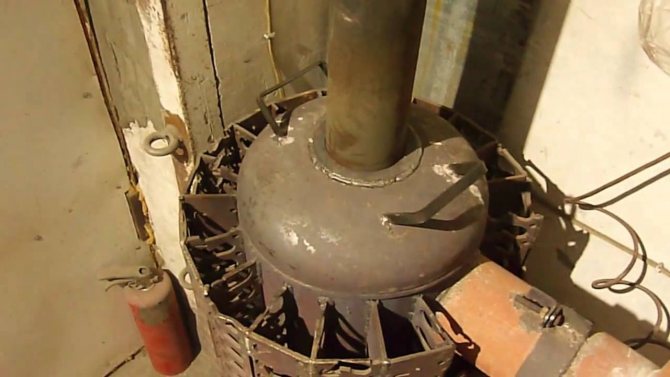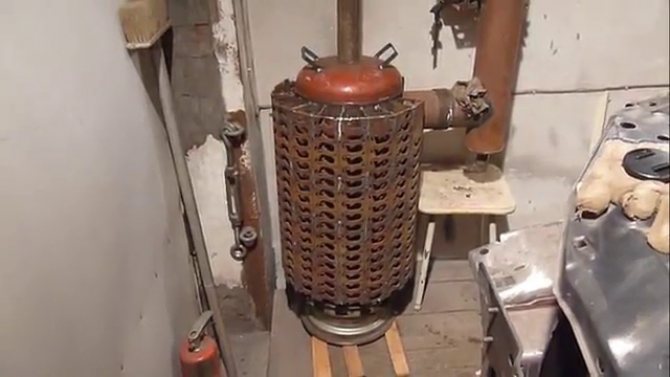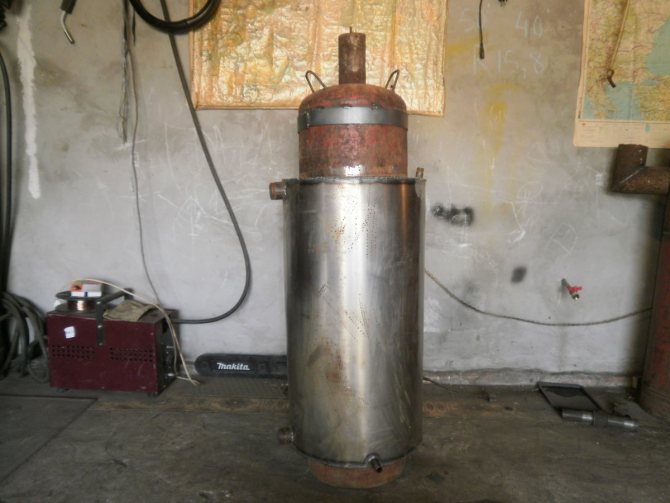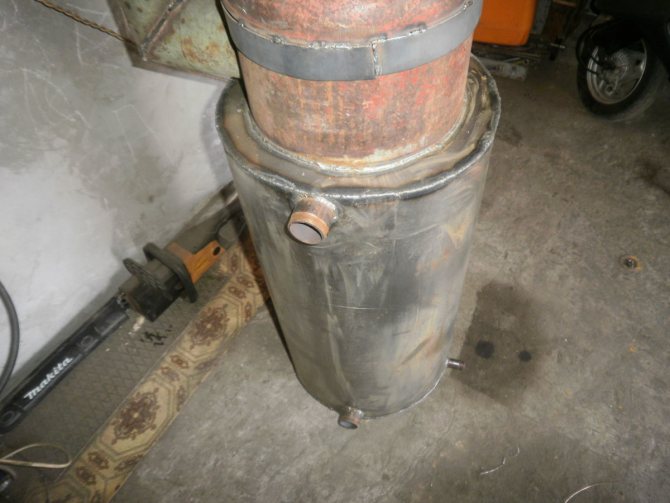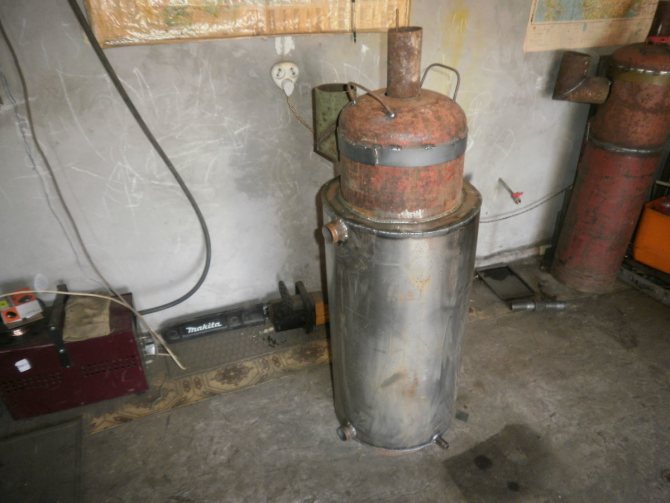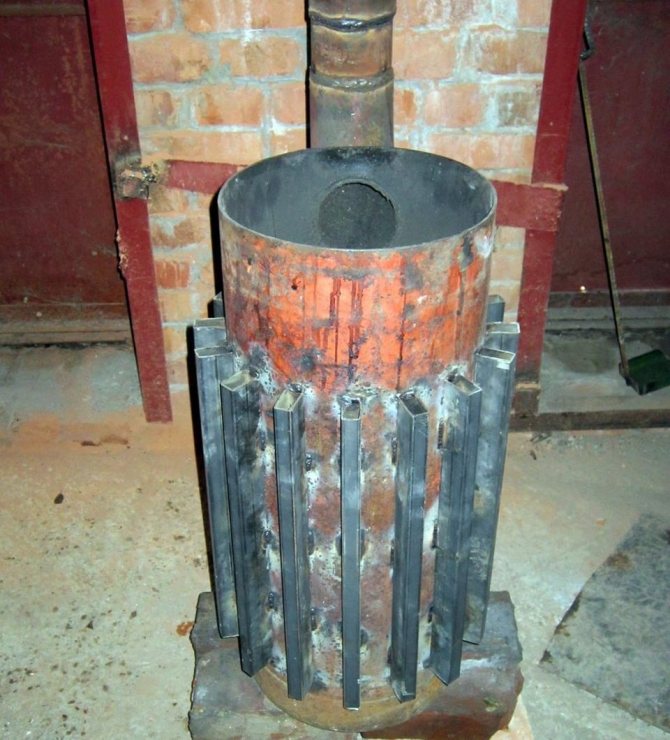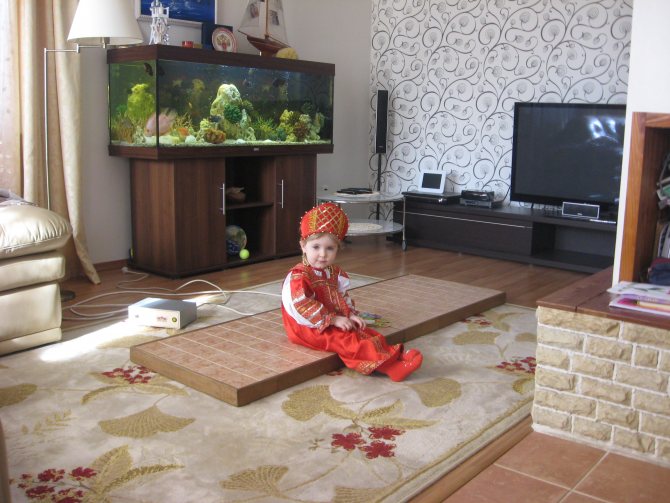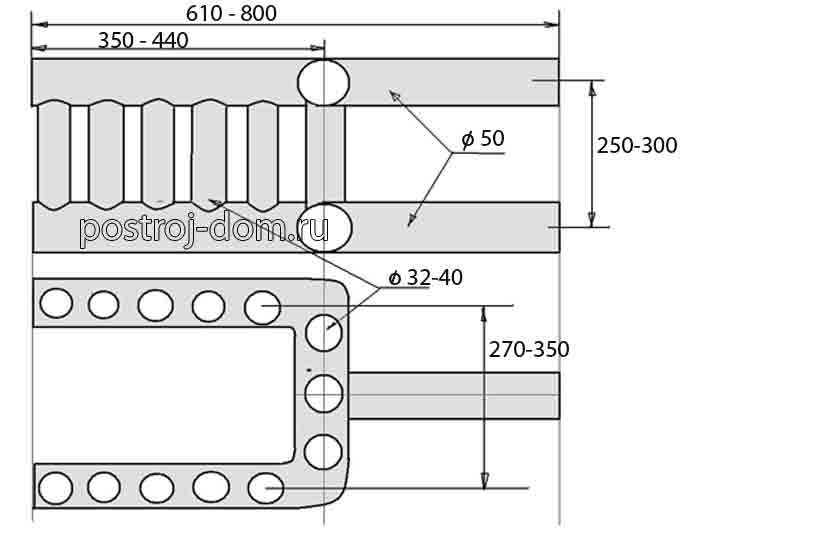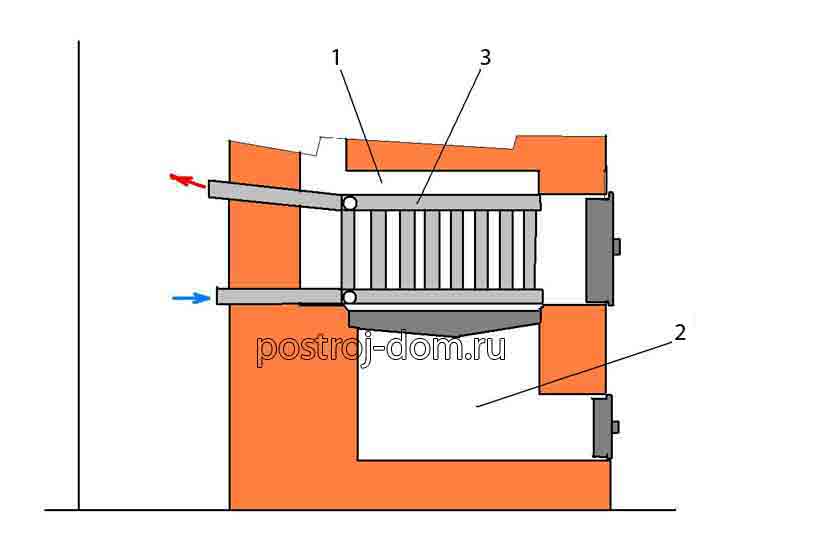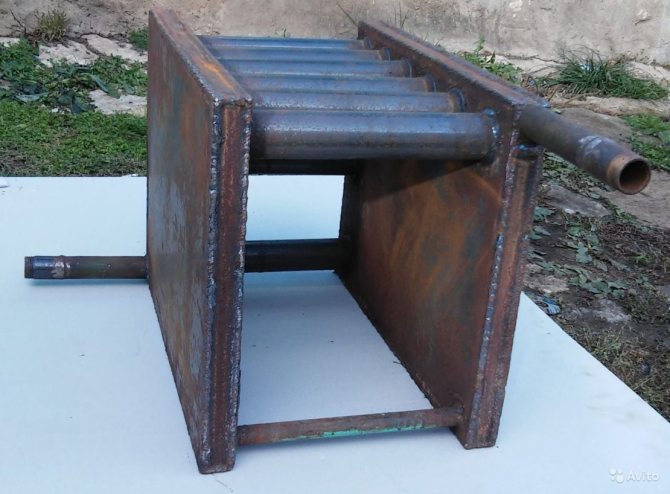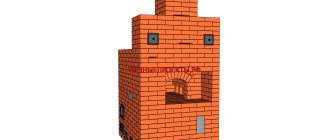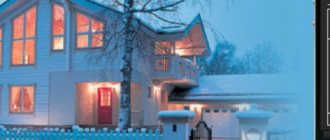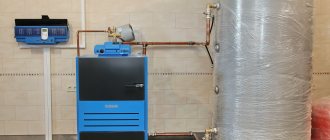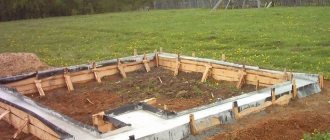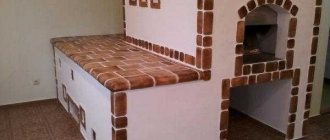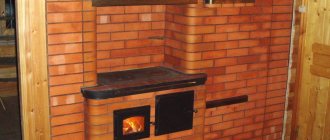A bit of history
Where did this design come from, and why is its popularity unabated these days? The history of the appearance of a potbelly stove begins at the end of the 18th century. Essentially, it is a cheap alternative to expensive fireplaces and stoves. The device gained particular popularity during the October Revolution, when all the norms and foundations of life were turned upside down. It became problematic to heat residential and non-residential premises, so this simple unit quickly spread throughout the country. After all, everything solid that could burn was used here as a fuel. And this is firewood, coal, peat, furniture, wooden windows and doors.
The potbelly stoves received the second round of popularity during the Great Patriotic War. In many cities, centralized heating networks did not work, and the country saved energy by sending them to the front. The population had no choice but to use the old proven method - to install potbelly stoves in their own apartments.
This oven saved a large number of people from freezing. It worked flawlessly, however, it consumed a lot of fuel. And this is its big minus. But this is the simplest and cheapest device that you can make with your own hands, and it is used in an elementary way.
Currently, potbelly stoves have found their application in country houses, garages, bathhouses and other outbuildings. In modern apartments, they were practically not used, if only as a decorative element, creating the style of antiquity. But recently, the fashion for them has returned.
True, consumers began to impose more stringent requirements on stoves-stoves:
- Reduced fire hazard.
- Presentable appearance.
- Economical fuel consumption.
Let's take a look at these requirements separately and reveal the secrets of the new popularity.
How does the stove work
It works according to a fairly simple principle.

Heat exchanger option
Water enters the heat exchanger, which is located in the fuel part of the stove. There it heats up from the combustion of wood or other fuel. Then, the already heated water enters the radiator batteries, where the heat from it is distributed throughout the room. When the water cools down, it returns to the coil, where it heats up again, etc.
Fire safety requirements
It is this selection criterion that is fundamental. Older stove designs are metal stoves made from segments of cast iron or sheet metal. Such units were not famous for a wide variety of forms. These were mainly cubic or cylindrical structures. The inner part is a firebox, where wood or coal was burned.
The fuel burned in the firebox and heated the device to very high temperatures. In fact, the stove was one incandescent element, from which any thing that got on its surface could catch fire. According to statistics, fires from operation occurred more often than from all other heating appliances in general.
If we talk about modern models, then they should be divided into two categories:
In the factory, where each technological stage is controlled for quality, it is possible to produce stoves that meet all fire safety standards and requirements. With homemade counterparts, things are worse. Nobody controls this production. Each master himself comes up with gadgets and devices that supposedly will protect the property of consumers from fire. That is, there is no guarantee.
Therefore, when the question arises which option to prefer, everyone decides for himself. It is important to prioritize here:
- The first is the high safety of operating a stove in an apartment.
- The second is the price equivalent. Of course, the homemade option is cheaper. But is it worth the risk of purchasing a low-quality device at a low price? After all, it can cost a hundred times more if a fire breaks out.
Construction of a heating device with a water jacket
Features of brickwork
The water circuit can be integrated both into a heating stove and into a heating and cooking stove. In both cases, the masonry technology will not be fundamentally different. A firebox and an ash pan, smoke channels and a pipe of a similar section are formed, standard doors, gates and hobs are used. The main difference lies in the increased dimensions of the combustion chamber, where the heat exchanger should fit and there should be room for a full load of firewood. If the coil is located in another place of the heat generator, then the combustion chamber also remains unchanged.
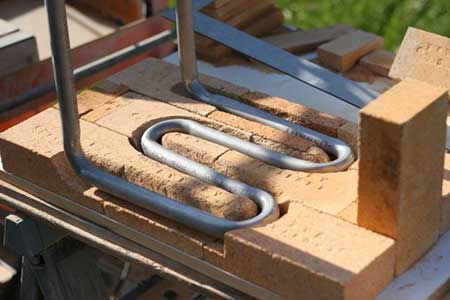

Sometimes registers are cut right into the kernel masonry
Important! A gap of about 10-12 mm should remain between the water jacket and the brickwork, so that during thermal expansion the metal does not expand the stove, and hot gases "lick" the heat exchanger from all sides.
For the construction of the main massif and the pipe, solid stove bricks and clay mortar are used. To protect the walls of the furnace, a core is created from chamotte and refractory mortar, which is not tied up with ordinary masonry.
Heat exchanger application
An important unit of a stove for water heating of a house is a heat exchanger, it is often called: "register", "water jacket", "boiler", "coil". This is a metal product (mainly steel, although there are factory cast-iron models), which is installed inside the firebox, or in cavities along the path of flue gases. In heating and cooking ovens, the heat exchanger can serve as the basis for installing a cast iron cooker.


Tube and sheet heat exchanger options
This element has to be made to order. For manufacturing, as a rule, steel pipes with thick walls (from 3 mm), with a diameter of 40-50 mm are used. You can also weld a sheet steel water jacket to remove heat. Usually this is a U-shaped box, which is placed inside the firebox and is its walls.
Important! It is believed that the installation of a heat exchanger in the smoke circulation is preferable to that in the firebox. In this case, nothing interferes with the combustion process, and the coil metal will last longer due to a more gentle operating mode.


The coil is outside the firebox, there will be no direct contact with the fire
Design of modern bourgeois
This category is broader. We will not do the layout by model, just consider a couple of options that will show how extensive the variety of ovens on offer is.
For example, the Marina stove stove. This is a cast-iron-steel unit, which is faced with special heat-resistant ceramic tiles. The manufacturer today offers a fairly wide color palette. Here, sandy color, creamy, red, green, brown and so on. That is, each consumer will find for himself such an option that will perfectly fit into the design of a city apartment.
We add that the weight of the device is only 195 kg. This allows the unit to be placed directly on a concrete floor slab without an additional slab foundation or plinth. With a power of 9 kW, this heater will heat up a city apartment with a total area of up to 90 m², not to mention a separate room.
The design of the stove provides for the combustion of solid fuel by the pyrolysis method. This is when the wood does not burn, but smolders in the combustion chamber. In this case, the flue gases are removed to the second furnace, where they are enriched with oxygen and burned. In essence, a two-stage combustion is obtained. Therefore, the efficiency of this type of bourgeois reaches 90%.In a traditional design, it is 75%. So the difference is impressive.
There are also stove stoves made of cast iron in the model line. This is a real work of art. Such furnaces are a sectional structure, each part of which is molded according to artistically designed sketches. In this case, the variety of decorative design is limited only by the imagination of a person.
Such stoves are most often made to order, so they are not cheap. Their technical and operational characteristics are very high. The design is thought out to the smallest detail - from the body and the firebox to the chimney. By the way, in all modern potbelly stoves, the chimney can be installed both on top of the device and on the side.
Types of water ovens
Furnaces equipped with a water circuit are made in several versions:
- installations operating on traditional wood. Let us make a reservation that such foci should not be too productive, since the outbreak of a foci is inevitable earlier than necessary.
- the Buleryan furnace differs in that it is not supposed to install a special register for heating the coolant. In Buleryan, water or antifreeze is heated in the oven itself, while an additional compartment is provided for increasing the productivity of the device, where wood gas enters.
- thermal furnaces made of durable cast iron are devices based on a cast iron body, where heat is obtained. Very good stoves, in simple terms, they are bought "for centuries", since cast iron is one of those materials that have high durability and reliability of their use. Only the water body in the device is made of thermal steel, everything else is cast iron.
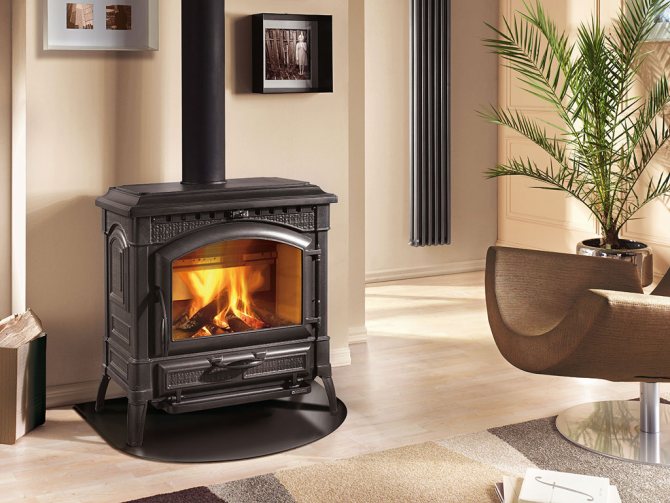

A hearth with a water body, or rather its functioning, can be controlled in three ways:
- the simplest: decreasing or increasing the portion of fuel affects the decrease or lowering of the temperature mark.
- to transform the temperature conditions, a special damper-regulator is used.
- the use of a circulation pump affects the rhythmic heating of the house.
Fuel economy
This is the last criterion for bourgeois, which are used in modern apartments. It has already been mentioned above about the designs of long-term combustion. They are today the most popular option when it comes to installing a stove in an apartment.
What is the design feature of this model? The thing is that the firebox of the device is divided into two parts - lower and upper. The split border can be horizontal or angled. It all depends on what conditions for the combustion of flue gases we are trying to achieve. With an angular location of the border, the combustion efficiency is slightly higher due to the higher gas concentration inside the narrowed part of the chamber.
Firewood or coal is usually smoldering in the lower firebox. In the upper part, oxygen-enriched flue gases are burned. Channels are specially installed for oxygen to enter the chamber. At the same time, there is one very important criterion that ensures full combustion of fuel in the first chamber. The fuel must be properly stacked, that is, with a minimum amount of gaps between its parts.
For example, if it is firewood, then they must be laid out horizontally in order or in the form of a cage. The distance from the walls of the stove should be minimal. If the stove has a cylindrical shape, then in addition to horizontally laid logs, it is necessary to lay firewood in a vertical direction. They must be placed in the gaps between the walls of the unit and the corners of the stacked firewood pyramid. In this state, a minimum amount of fresh air penetrates into the wood, but it is quite enough for the fuel to smolder.
The flue gases flow through the exhaust channels under the influence of physical laws upward into the second combustion chamber, where they burn, releasing additional heat.
Attention! One load of solid fuel is enough for a whole day. In traditional stove stoves, fuel fill is enough for only a couple of hours.
Choosing the best place
First of all, the principle of operation of the heater will help to determine the optimal location of the stove in the house. The location may vary depending on whether it is possible to build a chimney on a particular site and equip the correct operating area.
If you definitely want the stove to be located exactly in this place, then before its construction you need to calculate such an indicator as fire breaks: how far are constantly heating surfaces from walls covered with flammable materials.
You can more accurately determine the place of the stove in the house, based on the recommendations below:
- If the owner of the house has at his disposal hot-air heating devices, for example. "Potbelly stove" or "Buleryana", then they should be placed so that air flows can penetrate unhindered. This will create a convection system, thanks to which you can heat two adjacent rooms without doors.
- If the heating device has a built-in heat exchanger, then the placement of the stove can be any, subject to fire safety rules. However, it should be borne in mind that the furnace circuit must act as the lower boundary of the heating system.


Drawing of a standard log house
- It is impossible to install the stove, and at the same time avoid the construction of the chimney part and the pipe inside the house. In this case, the location directly depends on how it will be easier to connect the heater itself with the smoke extraction system.
- An important point is taking into account the free space when opening the door of the combustion chamber. If it is lacking, then there will be difficulties in order to clean and heat the stove in a wooden house.
- Buildings that are supposed to be heated by stoves must have a sufficient area so that fire breaks from heated surfaces to flammable elements can be observed, which corresponds to 1.1-1.25 meters. Also, the rule states that the distance to the opening door of the combustion chamber should not be less than 1 m 25 cm.
Good to know: How to choose a fireplace fence from children and animals
Useful Tips
- Installing a potbelly stove in a city apartment is a serious matter. It is never placed close to a wall or other supporting structure other than the floor. A minimum distance of 5–7 cm must be observed.
- In front of the firebox, non-combustible material must be laid on the floor. This is a safety precaution in case coal falls out of the combustion chamber. Although modern potbelly stoves for a city apartment are a reliable device, experts still believe that "God protects those who are careful."
- Do-it-yourself installation of the unit is not so difficult if you figure it out. Any man can cope with this process without much difficulty. But is it worth the risk? Therefore, we recommend calling a specialist, and let all the responsibility fall on his head.
- Special attitude to the chimney. If your potbelly stove will run on gas, then you can use the coaxial option for removing carbon monoxide gases. If wood or coal will be used as fuel, then we recommend an ordinary vertical chimney. The coaxial version with solid fuel combustion products, where soot is present in large quantities, may not be able to cope.
- Modern potbelly stoves can operate on different types of fuel. Of course, it was initially assumed that they would operate on solid fuels. This has always been the case. But the availability of various types of energy sources made it possible to create units of various designs. So the choice has become much wider. Here it is important to correctly place those elements that contribute to the combustion of a particular type of fuel.For example, gas burners are installed on gas stoves. In electric models, special heating elements are mounted.
Criteria for selecting a furnace with a water circuit
When choosing a finished product or planning to build a furnace with a water jacket with your own hands, you need to pay attention to the power of the installation. The larger the area of the room, the higher the power must be. The recoil of the heat exchanger should be taken into account.
The massiveness of the installation influences the choice of the base: if the stove for heating the house is heavy, it must be strong.
It is also important to calculate the volume of the coolant. For self-construction, you should choose the design of the smoke channel by calculating its diameter.
Furnace types
The history of the evolution of stove structures goes back many centuries. Unsurprisingly, folding a heat-efficient and reliable stove is an art form. But with proper preparation and diligence, you can do it yourself, here is a good video tutorial:
You can fold the oven using a variety of methods. At the same time, there are a number of parameters that determine the specifics of the future stove:
- Purpose.
- The temperature to which the walls should be heated.
- The time required to heat the walls and the amount of fuel required for this.
- Chimney design.
- Heat transfer level.
- Gas flow diagram in channels.
- The form.
- Exterior wall finishing material.
- Main material.
Based on all these parameters, you will fold the oven of your dreams. The main thing at the initial stage is to draw up a drawing, with detailed diagrams. The project needs to describe in detail all the features of the future design. But before that, you need to decide what kind of stove you need.
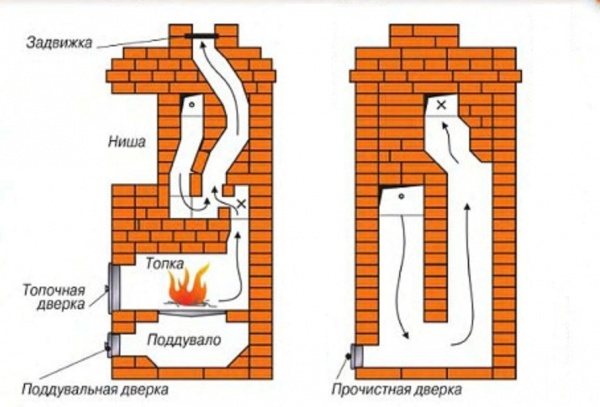

It is easiest to fold the heating stove. It performs the main function - it gives warmth to people and the home. Such structures do not carry any additional functionality, but they are reliable and easy to use, for which they have won many sympathies among summer residents.
Naturally, all heating stoves are classified according to heat transfer, the time required for kindling and the degree of heating of the walls. It is on these parameters that you need to rely first of all before folding the stove with your own hands.
If you expect to get a moderately heated stove, you can fold it into one brick. Such ovens heat up slowly and also cool down slowly. The average wall temperature is about 60 degrees.
Heating stoves cannot be called a refinement of architectural thought. But the massive design and uncomplicated shapes create a sense of monumentality. In addition, if you skillfully fold bricks in this stove, it can become an excellent decor element.


Moreover, do not forget about the exterior decoration. After you fold the stove, you can plaster it and put tiles on top. Firstly, it will protect the structure from destruction, and secondly, it will give it a beautiful and aesthetic appearance.
Typical representatives of the family of heating stoves include such designs as:
- "Dutch",
- OPT-3,
- Triangular oven,
- Stove Grum-Grigimailo,
- OTP-11
- Rectangular heating,
- T-shaped.
These ovens are rarely very popular. The fact is that in order to put them together it takes a lot of time and materials, and the functionality turns out to be poor as a result.
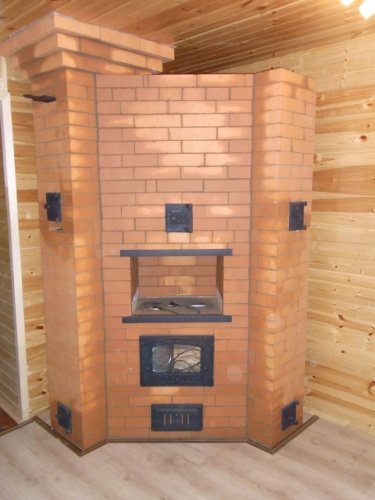

Very often, in country houses, the owners decide to lay down the heating and cooking stove. This construction has many advantages over a conventional stove. On it, without any problems and even comfortably, you can cook food using pine, birch or yew firewood.
The main element of such a stove is the hob, which is made of cast iron. The oven is not built in everywhere, since it takes a lot of skill to fold it. The most advanced designs have the following additional capabilities:
- a chamber for baking bread,
- stove bench,
- niche for drying firewood,
- boiler of water heating.
In fact, the number of additional functions depends solely on your capabilities and desires. In fact, a real multifunctional combine can be folded from a simple stove, which will become the main decoration of the kitchen. It's not even worth talking about savings. In addition, food made on such burners is always tastier.
Such ovens are able to keep warm for a long time. Not only that, they provide powerful traction. The main thing is to fold everything correctly so that the smoke goes directly into the chimney, and not inside the room. The most common designs:
As you can see, there is a huge variety of heating and cooking stoves, on which you can cook something tasty without problems and with the benefit of the family budget.
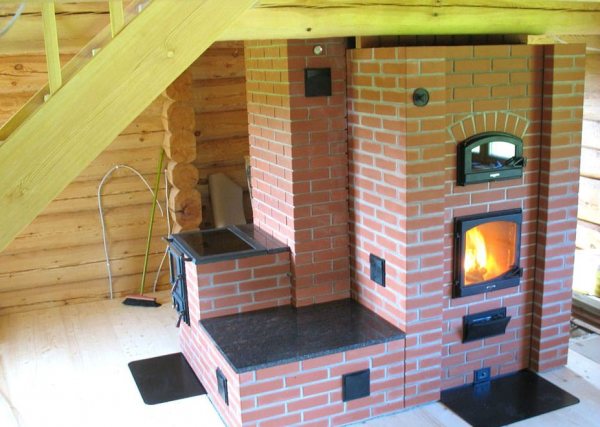

Constructions with heating shields are a cheap solution that includes all the functionality necessary for giving. To fold such a structure, you need a minimum of materials and physical labor. Enough 175 bricks for a full-fledged masonry.
Factory made furnaces
These types of stoves are used mainly for heating country houses, baths. For the production of furnaces use high-strength metal. Such ovens are easy to transport and install. Factory furnaces are small in size, which makes it possible to install them in small rooms. Structures heat up quickly and give off heat.
To heat the premises, factories produce heating stoves from cast iron or metal of various sizes and shapes, with a blind or glass door.
To use the stove simultaneously as a heating device and a hob, you can purchase a model of a heating and cooking stove. In this case, one heat source is used.
A cast iron fireplace stove will help to create a special interior in a country house or in the kitchen. On a winter evening, when a blizzard broke out outside the window, it is pleasant to sit by the fireplace blazing with a living fire with a cup of aromatic coffee and an interesting book.
If you want to try dishes, homemade bread, delicious pastries cooked in a real Russian oven, give preference to the device traditional type of oven, and for more comfortable heating of the house, supplement the device with a water circuit.
Which brick is better to fold the stove from
It is necessary to distinguish between ordinary heat-resistant bricks from oven bricks. Firstly, the latter can withstand temperatures above 1000 degrees. Secondly, if it is rapidly cooled, no cracks form in the structure.
For the construction of stoves, four types of stove bricks are used:
- Quartz. This brick is the result of firing sand and clay.
- Carbonaceous - consists of graphite.
- Fireclay. Best for a fireplace. But one cannot discount its unique thermal insulation qualities. It is able to withstand temperatures up to 1600 degrees. At the same time, it does not crack and does not lose its qualities. The only negative is the yellowish tint.
- The main one is used when you need to fold the metallurgical furnace.
In reality, there are no strict rules regarding the choice of materials for masonry during construction. Nevertheless, there are some recommendations that are best followed, the main one of which concerns fireclay bricks. It should be placed in the hottest places, namely in the area of the firebox and chimney. For all other zones, the grade must be at least M-200.
What are the principles for determining the installation location
It is worth understanding that the question of where the stove should be located in the house is extremely important and responsible, therefore, it is worthwhile to approach the search for an answer with special care.
The principles for determining the location are as follows:
- Any stove should be as close to the central part of the house as possible so that the external chimney does not go far from the ridge.
- The correct location of the device will be in the event that other communications are not carried out under it, for example, water supply.
- When installing two ovens in one zone, it is still better to design for each foundation in order to protect yourself from the rapid destruction of products.


The location of the pipe relative to the ridge of the house
In addition, it is worthwhile to clearly understand that one structure must heat at least two rooms, otherwise its installation will not be advisable.
Good to know: How to prepare fireclay clay for laying a stove, how to mix a solution
Do-it-yourself oven
Seat selection
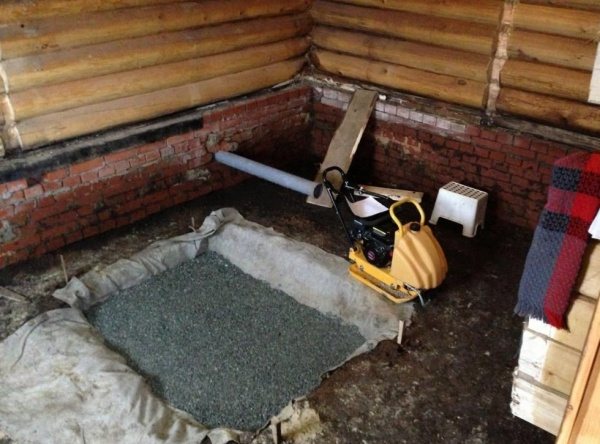

To fold a good heating structure, you need to choose the right place. In doing so, the following standards should be taken into account:
- From the chimney to wooden structures, it must be more than 37 cm.
- The minimum distance of the pipe from the ridge is one and a half meters. The height above the ridge is half a meter.
- If it is 1.5-3 meters from the pipe to the ridge, it can be placed flush with it.
It is best to fold the stove in the middle of the house. This will ensure even heat distribution and ease of use.
Materials and tools
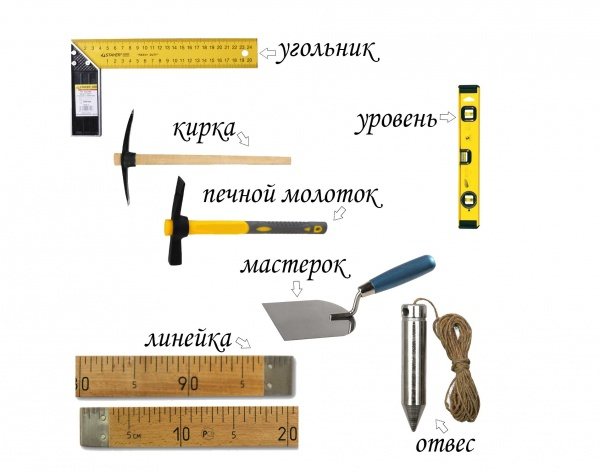

In addition to brick, you will also need a number of other materials to fold the stove. These include:
These are the main materials without taking into account the components, but you still need to take care of the vents doors, the blower, the firebox, and so on.
To fold a good stove, you need to knead the right solution. It is best to use special refractory clay, in extreme cases, you can also red. Grains of sand should be no more than 1 mm. The optimal ratio is achieved empirically. This is usually 1 to 1 or 1 to 2. Plus 25 percent water from the total clay.
Metal objects play the main role in the construction of the furnace. To fold a decent structure, you need doors and half doors, grates, cast iron dampers, latches and views. All these elements, if necessary, can be made by hand, but you will need to purchase iron sheets.
Of course, you won't be able to fold the stove without good tools, you will need:
- hammer-pick specially for the oven,
- Master OK,
- rule-ruler,
- wash brush,
- roulette,
- plumb line
- level.
With this simple toolkit, you can fold any oven.
Stove construction process
For the foundation, a pit is dug, backfill and a reinforced frame are made. The resulting structure is poured with concrete. Before folding the stove, make sure you have brick patterns in front of your eyes.
It is very important to keep order when working. Otherwise, you will not be able to fold a high-quality oven. The slightest deviation in the design will lead to the fact that one of the channels will be blocked. The result is more than disastrous. The smoke, instead of going out through the chimney, will go into the room.
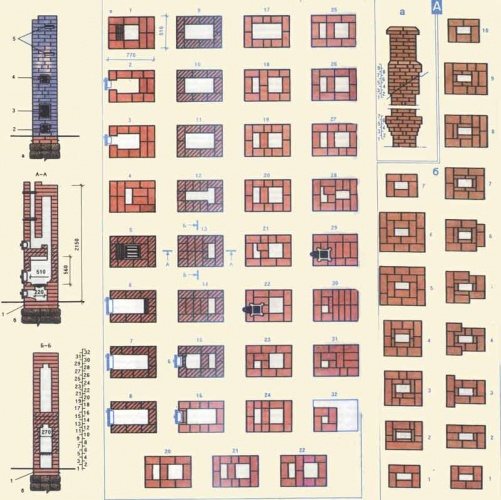

The first row is laid along the cord. Each next masonry is checked using a level. The corners are controlled by body kits. After the laying is completed, the stove equipment is installed, for example, the burners. The pipe is led out at the very end. To learn more about how to fold the oven, see the video below:
In order to fold the stove in accordance with current standards, the distance from the inner wall of the chimney to the nearest structure must be at least 38 centimeters. When installing a cast iron plate, the gaps on the sides should be at least 5 millimeters.
Traditional stove and hot water heating
You can significantly improve the advantages and reduce the disadvantages of traditional stove heating by connecting to the stove water heating. First of all, the heating area increases significantly, heat is rationally and evenly distributed throughout all heated rooms. The heating of the room involves the smoke channels of the furnace, walls and a heat carrier. Heat transfer to radiators occurs only when the furnace is in operation. After stopping burning keep warm in the radiators for some time.
The device of a stove with water heating differs from a conventional stove by the presence of a heat exchanger, installed in the firebox.The simplest water system is connected to the register. The design of the heat exchanger can be different, but in any case, it should warm up the coolant well and provide high-quality circulation. For the production of registers are used metal pipes or sheet steel.
The most popular system of stove water heating is among the inhabitants of villages and villages, where there is no gas pipeline. In this case, improved stove heating is the only way to heat the house during the cold season. Such heating works even during a power outage.
Many owners of stove water heating install circulation pumps to improve the circulation of the coolant and increase the efficiency of the system. The combined installation of an expansion tank and a pump allows the entire heating system to operate smoothly in all conditions. The main thing is to melt the firebox and periodically add fuel to maintain the optimal temperature in the system.
The device of stove heating, combined with water, costs the owner of the house much cheaper, than purchasing a factory-made boiler.
Disadvantages of using stove heating with a water circuit:
- to maintain the optimal temperature in the house, the stove is heated every day;
- when using this type of room heating, it is impossible to install the stove in the basement as it is done when using a factory solid fuel boiler;
- it is necessary to strictly follow the rules for installing the entire system in order to ensure sufficient circulation of the coolant;
- high temperature differences during the operation of the furnace sharply limit the choice of material for the heat exchanger; only registers made of metal pipes or sheet steel can be installed in furnaces;
- this type of heating cannot be arranged using only forced circulation.
If you are the owner of a small building, but really want to install in the house stove heating, an excellent solution would be to purchase a factory oven.
Outcomes
Folding the stove is within the power of each person. The main thing is to choose the right look from the very beginning and draw up a project where you need to describe in detail the features of the future stove. In order not to bother creating unique drawings, you can take ready-made drawings.
The comfort of a country house built far from gas supply networks is unthinkable without a stove. In the cold season, it gives us pleasant warmth, ridding the air of dampness.
The market today offers buyers all kinds of designs of metal "burzhuikas". Despite this, many summer residents prefer the classic version - a brick-built heating stove. Its advantages are obvious: due to its high weight, it accumulates a lot of heat and gives it away for a long time, warming up the room well.
The content of the article:
The service life of a brick structure significantly exceeds the service life of a metal one. The minimum cost of materials and ease of arrangement attract the attention of home craftsmen to a simple stove for giving.
Our article will help you test yourself as a stove-maker. In it, we will consider several options for simple wood-burning stoves and give practical recommendations for laying them.
You will be convinced that there is nothing complicated in the drawings of these structures. Having learned to read "orders" - brick layout schemes, you can build a full-fledged heat generating device with your own hands.
Operating rules
The laying of the stove must be carried out by a master in compliance with all norms and requirements. Whitewash chimneys and root pipes once a year in order to timely detect the appearance of cracks in the structure. The floor near the stove and wooden structures located next to the chimney, are upholstered with tin... Use dried firewood for kindling, refrain from using flammable substances. Do not stack firewood, peat, briquettes, paper and flammable liquids near a burning stove.
Engage in kindling the furnace, support the combustion process adults only... Place furniture at a distance 50 cm from the oven.
The brick oven is supplied outlet valve, necessary to preserve heat in the house and regulate the release of carbon monoxide. By making only a few through holes in the valve, you can avoid the risk of gas poisoning if the valve is not closed in time.
How to fold the simplest brick oven?
First you need to decide what you want to get from the future stove. If you only need to heat the rooms, and you use bottled gas or electricity for cooking, then choose the option without a stove and an oven. Anyone who loves soft, healing warmth chooses the option with a stove bench.
For regular cooking of large quantities of food and pet food, a simple oven with a hob will do just fine.
We'll look at three examples of ovens with a step-by-step guide to laying them:
- Simple straight-through;
- With a hob;
- Heating.
Let's say right away that one cannot expect high heat transfer from a simple design, devoid of gas revolutions. For this reason, such stoves are installed in garages and other small rooms with an area of no more than 16 m2.
We will consider this option so that beginners get their first simple lesson in practical masonry.
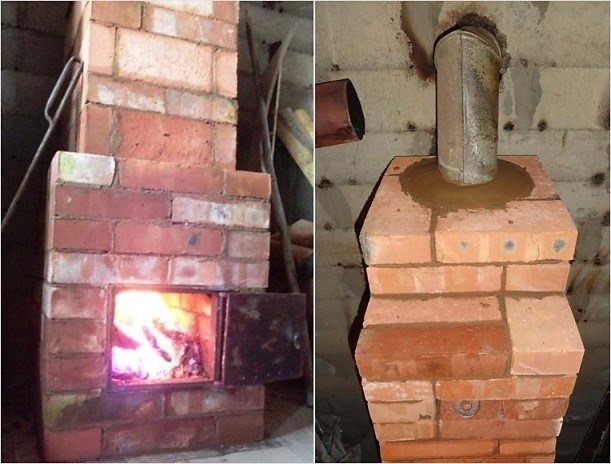

A powerful foundation is not needed for such a stove. Having poured large gravel with a layer of 15-20 cm, filling it with cement mortar and leveling the surface to a level, in a couple of days you can start laying.
The dimensions of the furnace in the plan: width 2 bricks (51 cm), depth 2.5 bricks (64 cm). Since there is no blower chamber in it, holes for air intake are drilled directly in the furnace door.
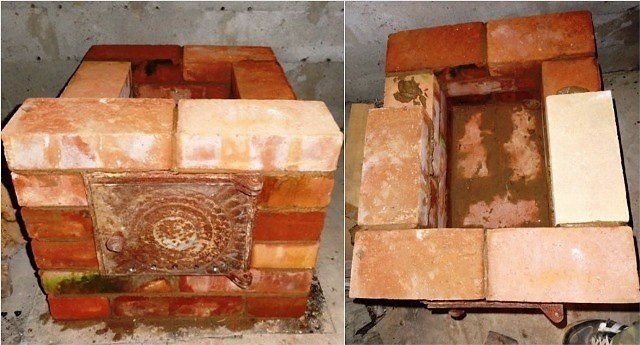

The orders of this design are simple. The main condition during work is to observe the dressing of the seams so that the upper brick covers the seam between the two lower ones.
DIY potbelly stove with a water circuit
When installing this type of heating system, you can both build a water boiler into a potbelly stove, and create the furnace itself from scratch. Therefore, the process can be conditionally divided into two stages.
We also recommend that you study the article: Water heating from the stove on our website!
Formation of a potbelly stove
Before starting work, drawings are drawn up, including all dimensions of the furnace, and the main materials for working with metal are prepared: a welding machine, a hammer, a grinder, as well as pliers and overalls.
When making a diagram of a potbelly stove with a water jacket with your own hands, it is important to take into account the thickness of the elements of the future unit.
After the metal has been cut out, you can proceed to further steps:
- Connect the bottom to the walls, excluding the front. All elements should be welded at right angles.
Important: It is better to set the bottom of the stove at the level of 25-30 cm from the floor. Thus, by using the designed metal feet, the effect of heating on the flooring can be reduced.
- A partition is welded into the space between the firebox and the blower. It is necessary to drill several longitudinal holes in it, through which ash will be removed.
The blower opening should be up to 3 cm smaller than the blower itself.
- On the front wall, openings are made for the doors. Then it can be installed to the basic structure;
- On the sides of the front part, awnings are added, doors are placed;
It is better to equip all doors with a deadbolt.
- A chimney is welded to the top of the stove. Upon completion of the work, it is necessary to check all parts for defects in the seams. If none are found, you can proceed to the next step - adding a water circuit.
A water fireplace brings not only home comfort and warmth.This is a great addition to the interior that will make your home more sophisticated. A feature of the fireplace is good heating of the house when compared to an ordinary fireplace. The main thing is to follow the installation instructions.
Adding a water circuit to a potbelly stove
The basis of this type of furnace is a heat exchanger, which can be constructed from different materials, for example, hollow steel pipes or steel sheets. In addition to a heat exchanger, to create a potbelly stove with a water circuit, you will need:
- Finished furnace body.
- Radiators.
- Pipes.
- Metal sheets.
We advise you to read about water heating from the stove on our website.
The installation of the system is carried out as follows:
- In the upper part of the potbelly stove base, two holes are made for supplying and returning water.
To simplify the work will help drawing up a drawing of a future potbelly stove with a water circuit, created independently.
- A water tank is formed from metal or from other suitable unused materials; the largest space should be allocated for it in comparison with the firebox and ash pan. Holes are made in the tank for nozzles, then it is installed behind the firebox. The space is separated by a sheet of metal.
- Next, the piping is installed. It can be one-, two-pipe and collector.
Important: The two-pipe design is more preferable, since it allows you to change the temperature using the installed valves and provides uniform heating in contrast to the one-pipe design. The collector room is quite complicated for self-erection.
- The next step is to serially connect the pipes with radiators throughout the house.
It is recommended to install radiators under windows. This will increase the thermal conductivity of the potbelly stove. The design of a potbelly stove with a water circuit is checked for holes where water can flow out through the circuit.
- An expansion tank is installed to the supply line, which will exclude the supply of cold water. Its size is selected based on the volume of water that will be in the entire system - the tank should be made 20% larger.
An example of a potbelly stove with an expansion tank
- With proper erection, the water will heat up in the heat exchanger, pass through the pipes to the radiators, cool down and return to the heat exchanger again.
We advise you to read in more detail about the types of heat exchangers in addition to this material.
The finished structure can be painted or bricked, depending on which appearance is preferable for the owner.
Video: project of a potbelly stove with a water circuit
With the help of a potbelly stove with a water jacket designed by your own hands, you can significantly save on heating a country house. Such a structure can provide any room with the required amount of heat.
07/05/2016 1421 Pechnik (Moscow)
Installing a water stove in any private house will solve many problems associated with space heating, and will also help save fuel costs. In addition, almost any type of fuel can be suitable for using a heating device, and the productivity of a hearth equipped with a water jacket will be much higher.
Oven with hob
In the simplest version, such a structure has small dimensions (width 2, and depth 3 bricks - 78x53 cm). Nevertheless, even in such a limited area, a single-burner stove can be placed.
Work gets done when you have everything you need at hand.
Therefore, buy the following materials and accessories in advance:
- Solid red brick - 107 pcs;
- Blowing door - 1 piece;
- Grizzly grate - 1 piece;
- One-burner cast-iron stove - 1 piece;
- Furnace door - 1 piece;
- Pipe gate valve - 1 pc.
Refractory bricks for a wood-burning stove are not needed. Buying it is a waste of money. But red should be chosen carefully, rejecting cracked and uneven.
Solution preparation
The masonry mixture is made by mixing four parts of clay with one part of water and adding eight parts of sifted sand to them. The normal consistency is determined simply: the mortar easily slides off the trowel without leaving streaks on it. When laying, it should not flow out of the seams.
The volume of the solution is determined based on the number of bricks. With an optimal seam thickness (3-5 mm), one bucket is enough for 50 pieces.
Having prepared the masonry mixture, you can start laying the base. Its width is made 10 cm more than the width of the oven. The height of the foundation is selected so that the bottom of the first row of bricks is at floor level.
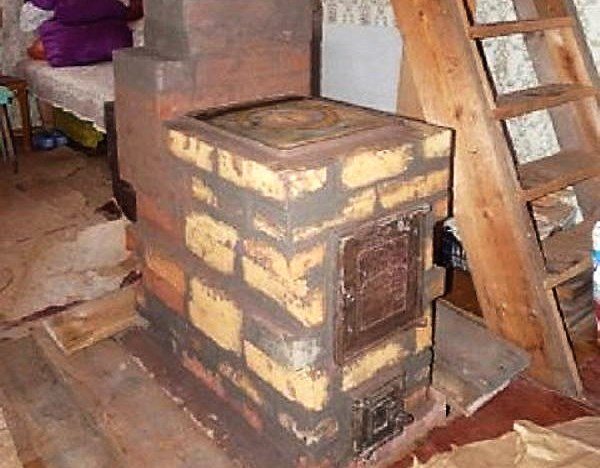

If the underground is deep enough (50-60 cm), then there is no need to dig a hole under the foundation. It is enough to make a formwork on the ground with a plan size of 76 x (51 + 10cm). Two layers of roofing material are laid on its bottom to protect it from moisture. Having laid the concrete, he is given a week to gain strength, after which they start laying.
The dimensions of the oven we are considering with a hob are 3 x 1.5 bricks (76x39 cm).
Master's advice: lay out each new tier of brick without mortar (dry). After adjusting the bricks to size, you can start laying.
The first row is placed on a layer of clay mortar (4-5 mm). Aligning the base with a level, lay out the second, leaving room for the blower door.
Before installing the door, you need to screw a soft wire to it and lay its ends into the seams for better fixation.
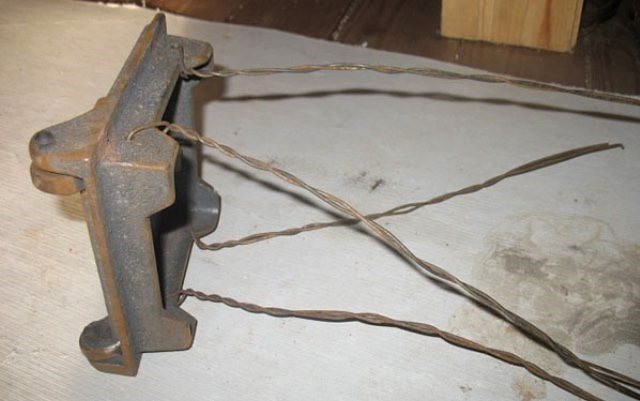

To compensate for the thermal expansion of the metal, a gap is left between the door and the brick. Before installation, its frame is wrapped with a wet asbestos cord.
The masonry of the third row is carried out, overlapping the seams of the second. At this level, a grate is installed in the firebox.


The fourth row is placed on the edge, observing the dressing of the seams, and the walls of the combustion chamber are formed. Behind it there will be the first and only smoke circulation (see section А-А in the scheme №2). To clean its bottom, a so-called knockout brick is placed in the rear wall without mortar, periodically removed to remove ash. Inside the chimney, two supports are made of pieces of brick to support the internal partition.
The stones of the fifth row are placed flat, leaving room for the furnace door. At the rear of the stove, in order, we see the walls of two smoke channels. During work, their surface must be thoroughly cleaned with a wet cloth from the clay protruding from the seams. This is an important prerequisite for good traction.
Helpful advice! Focusing on the order drawings, do not forget to look at the two cuts of the stove. They will help you better imagine its design and not make mistakes when laying out bricks.


Raising it into the masonry up to the eighth row, they block the fire door, laying a wire in the seams that fixes its frame. At the same level, a brick with a beveled end - a smoke tooth - is placed in the back of the fuel chamber. It improves heat output by preventing flue gases from escaping quickly into the chimney.
Having finished the ninth row, an asbestos cord is laid on it in a clay solution. It is necessary to seal the joints of the cast iron plate and brick. On the tenth row, the firebox is covered with a hob.
On the eleventh, a smoke damper is installed in the pipe. It is also compacted along the contour with an asbestos cord dipped in clay.
12 and 13 row - the formation of the pipe walls. After their completion, a light sheet metal pipe is placed on the furnace, which is brought out to the roof.
Safety measures during operation
Due to the fact that this equipment is difficult to control with the help of automation, the risk of its overheating and the penetration of carbon monoxide into the room increases. In order for a wood-burning stove boiler for water heating to work as safely as possible, it is necessary to adhere to several rules
- Continuous monitoring of the main parameters: pressure and temperature by means of manometers and thermometers installed on the supply and return lines.
- Periodic inspection of the smoke ducts.To do this, it is necessary to inspect them for cleanliness and permeability before the start of each heating season.
- Cleaning the heat exchanger. A layer of soot 1 cm thick leads to a drop in efficiency by 10%, so the removal of combustion products should be carried out as they stick to the walls of the firebox.
- Inadmissibility of using equipment during the summer season, when the water is drained from the system. Overheating of an empty heat exchanger will lead to destruction.
